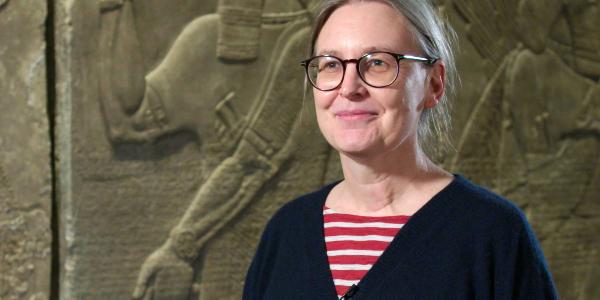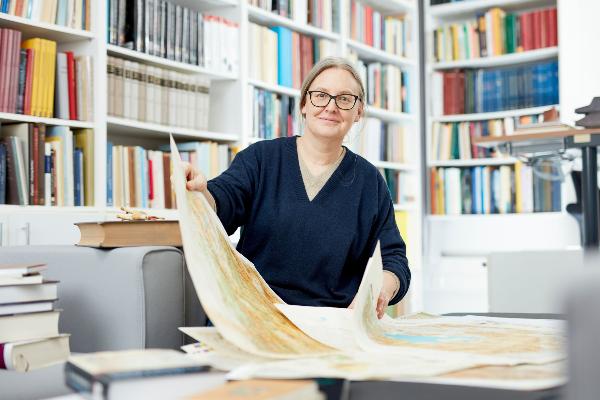Why is it important to study ancient Assyria today?
Karen Radner: When Assyrian history was rediscovered in the 19th century and the first artifacts were taken from northern Iraq to Europe and cuneiform script was deciphered, people saw Assyria mainly through the lens of the Old Testament as the destroyer of Israel and besieger of Jerusalem. It was not easy for Assyria to shake off this bad image, which still clings to it today. Very few people have even heard of Assyria, but when they have, their associations are still strongly influenced by the Bible. What many people do not know is that from the 9th century BC onward, Assyria was an empire that was capable of overcoming many obstacles of geography and climate. These obstacles still exist today in the form of deserts, high mountains, and seasonal extremes, and they determine the political fragmentation in the Near East. I’m interested in how people communicated in this large state, how they delegated power. Assyria is fascinating for anyone with an interest in how large, complex organizations work. I like talking with economists, for example, as I think one can learn much of value from the solutions the Assyrians came up with for the organization of their empire.
How did this powerful empire come to ruin?
Assyria collapsed in the final years of the 7th century BC. The Assyrian kingdom was conquered by the Medes and the Babylonians. To this day, there is no successor to the Assyrian state exist at the political level. But in broader, structural terms, Assyria had a huge influence on all later super-states of such magnitude.
Where do you carry out your research?
I do research wherever I find myself. Preferably of course on site in Iraq, in Syria, in eastern Turkey, or in western Iran. All these regions were part of the Assyrian Empire. I spend a lot of time on field trips, and last year alone I was in Iraq five times to resume excavations in Assur – the city that gave the Assyrian Empire its name.
The heartland of ancient Assyria is in modern-day northern Iraq and in Syria. Media reports about these two areas are focused almost exclusively on war and crisis, but that does not do justice to the region’s historical significance. During the heyday of the Assyrian Empire, these areas were the intellectual and cultural center of the world.
What is your focus during excavations?
Socially, Assyria was a very strongly differentiated society with clear hierarchies. Naturally, there are royal palaces to excavate, but personally I prefer to work on residential architecture. For all the differences in social status, all people have the same basic needs. In the Assyrian Empire, for example, every house had a bathroom – which one of course cannot take for granted – and you could bake bread inside. And this is true for every house, whether it measured 25 square meters or 3,000.
It’s conspicuous, moreover, that there was very little furniture. The only people in Assyria that could use a footstool, for instance, were the king and the queen. Certain objects were reserved exclusively for the highest echelons of society. This shows us that people had a very different attitude to consumption back then. As well as illustrating how Assyrian society worked, this also raises questions about how our society works today. It helps us appreciate that there are always alternatives to how we live as a society.
What is your current research project about?
Winning a Leibniz Prize in the spring of last year has enabled me to begin a large project: We’re going to resume digging in the Assyrian capital Assur and excavate the so-called New Town.
The city of Assur had been in existence on the western shore of the Tigris since the third millennium BC. In the 9th century BC, a major new development was built in the south of the city. Part of what makes this New Town so interesting for me is the fact that it was founded at an historical moment when Assur was no longer the capital of the empire. King Assurnasirpal II had recently moved the seat of government from Assur to Kalhu, which is today also known as Nimrud. Although this meant that Assur lost important powers, it remained the cultural capital of the Assyrian Empire, because it housed the only temple to the eponymous god Assur. Why the New Town was founded at that time is unclear.
Our current project is also a sort of rescue excavation, as another dam may be built on the Tigris, which will then raise the water level and threaten the New Town. Although the most recent news is that this dam will not be built after all, the danger remains, because drought is a major problem in central Iraq.
What are you planning for the current excavation campaign?
On site, we will take a lot of samples. These will contain charcoal, human teeth, animal bones, paleobotanical samples, and much more besides. This will help us develop a much more exact picture of the lives of people in Assur from the 9th to the late 7th century BC than has been possible before now.
Prof. Dr. Karen Radner is Head of the Alexander von Humboldt-Chair for the Ancient History of the Near and Middle East.


